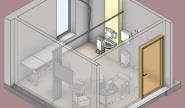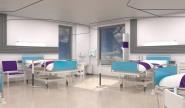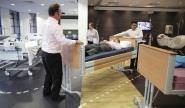‘Repeatable rooms’ are just one part of a design strategy that the partners of ProCure21+ say will save money and improve the patient experience, writes Jennifer Trueland

Procure 21 national event

How do you cut costs in healthcare while maintaining or, ideally, improving quality and patient outcomes?
According to health planner and former NHS manager Stephanie Brada, what you do not do is indulge in expensive individuality which is not grounded in evidence.
Ms Brada is among those calling for a revolution in the way hospital rooms are designed and developed. She sees huge potential in greater standardisation, specifically in repeatable hospital rooms and components, and believes there’s a pressing need to make it happen.
“If you ask 20 trusts to come up with a design for a hospital room, you’ll get 20 variations,” she says ruefully. “Each variation costs the NHS an enormous amount of money, yet it’s likely the differences aren’t actually grounded in evidence.”
It was to address that very issue that the principal supply chain partners which make up capital procurement framework ProCure21+ came up with the concept of repeatable rooms and standardised components, which they wanted to make available to NHS clients. Ms Brada is core team healthcare planner for ProCure21+.

Following a thorough process, which involved extensive consultation and an innovative analysis of the evidence base on hospital room design, the resulting repeatable rooms and standard components were launched at an event in February.
The designs are robust, says programme director David Kershaw, because they are grounded in evidence. They also have the potential to realise significant savings for the NHS, while improving outcomes and the patient experience.
He has calculated that, if adopted by the NHS, the repeatable rooms and associated component standardisation would go a long way to meeting the requirements of the government’s construction strategy.

“The designs can be used for new builds and for refurbishment,” he says. “Feedback so far has been very good, and we’re confident this is the way ahead for the NHS.”
Ms Brada, who has been closely involved in the development process, agrees. She says that making sure the designs were based on the best evidence is crucial. “There is endless repetition in the NHS, but a lot of the variations are based on hunch and the personal experience of the people in the room.
“We wanted to make sure that we didn’t just look at summaries of the available research - we wanted to go back to first principles and look at the actual studies and see what the evidence actually is.
“We also found there were evidence gaps, where more research was needed. And, importantly, we found that an awful lot of money was being spent on things for which there was very little evidence.”
Robust canvas

Does the repeatable rooms concept deny hospitals the right to adapt rooms to fit their local needs? Not at all, says core team architect Rosemary Jenssen. “I’ve been a healthcare architect for 19 years and traditionally, trusts that are planning rooms will start off almost with a blank sheet of paper. They will go through a lengthy process looking at every element - that uses up a lot of clinician and manager time.
“With this process we’ve done a lot of this work already and the basics - supported by evidence - are in place. That means we’re providing trusts with a robust blank canvas and they can build on that. There’s still an opportunity for creativity, but with much more support than previously.”
‘The initiative means the NHS will have the best buildings, the best rooms and the best equipment in which to provide the best care for patients’
The research-gathering exercise and the consultation process underlined that the way healthcare is delivered is changing, and environments must develop to support that.Take the designs for consultation and examination rooms, for example. Ms Jenssen points out that relationships between clinicians and patients are changing, from one where the doctor was “in charge” to a partnership of equals.
This is reflected in the room designs, which have non-hierarchical seating arrangements where it is possible for patient and clinician to see the computer screen and to interact on equal terms.
It’s not just about what suits the here and now, Ms Jenssen emphasises. The designs have to take into account likely future demands on healthcare - for example by including storage space for equipment which might not even have been invented yet but which might become a staple of ward life in the future.
One interesting outcome of the research, she says, is that so much healthcare is still “hands on”. Some 80 per cent of those questioned in a patient survey said their outpatient consultation involved some form of physical examination, or “laying on of hands”. This suggests that face-to-face consultations are still very much the norm, despite advances in approaches using telehealth, she says.
Ms Jenssen argues there’s no question that this is the way forward. “It’s really exciting and I’m looking forward to seeing the project go to the next step,” she says.
The rooms have backing at the highest level. Health minister Dr Dan Poulter gave the keynote speech at the launch of the repeatable rooms and standard components scheme, and expressed enthusiasm for the scheme. Likewise, Peter Hansford, the government’s chief construction adviser, has openly supported it. The NHS is clearly being encouraged to make use of the initiative. A Department of Health spokesperson says: “We are working with construction companies to create good quality, better value NHS facilities. Repeatable rooms have been designed by the NHS and are now available. Using these rooms will save money on facilities costs - meaning more can be spent on patient care.”
It is not just about the money, however. The spokesperson adds: “Most importantly, the initiative means the NHS will have the best buildings, the best rooms and the best equipment in which to provide the best care for patients.”
As well as the room designs, ProCure21+ has negotiated substantial discounts in standardised components by agreeing cost savings on items such as lighting, flooring and sanitary ware. This, along with the space savings of the rooms themselves, has the potential to cut costs by up to 11 per cent - or even more as additional rooms and components are added.
Ms Brada believes the initiative has applications beyond England.
“We’ve talked to colleagues in America and they have exactly the same issues,” she says. “For example, in mental health rooms, how do you get the right balance between a therapeutic environment and an environment that is safe? There are solutions, but these don’t have to be in 57 varieties,” she argues.
David Kershaw: When ‘standard’ is anything but
Never has there been greater pressure on the NHS to deliver more for less. The current economic climate has focused all trusts on efficiency of capital and process, underpinned by the Government Construction Strategy that requires cost savings by 2015.
In light of these pressures, the Department of Health, under the ProCure21+ capital procurement framework, together with the framework’s six principal supply chain partners (PSCPs), has launched the Repeatable Rooms and Standardised Components initiative. Its aim is to help trusts meet targets on capital expenditure, while maintaining and improving patient outcomes and quality levels.
Repeatable rooms available include a single bedroom with three options for en-suite bathroom; a four-bed bay in three layouts; a consultation room; and four consult/exam rooms with two- or three-sided couch access.
Standardised components include flooring, ceiling, doorsets, sanitary ware and lighting. All room designs and components are suitable for new build or refurbishment, are Health Building Notes compliant, and can collectively achieve up to 11 per cent savings over bespoke designs. The designs are available now, free to users of ProCure21+, at www.procure21plus.nhs.net/club
A core team of staff from the six PSCPs brought together stakeholders and experts from across the NHS, academia and supply chains, beginning with a comprehensive literature review that was used to inform the first designs. Designs were then subjected to scrutiny by expert panel workshops including clinicians, estates and facilities management professionals, designers, patients, infection prevention nurses, NHS England, the royal colleges and over 60 NHS trusts.
The resulting initiative has attracted widespread high level support. Speaking at a launch this year, health minister Dr Dan Poulter said he would like to see these designs in use at local level, “saving every trust money that can be put into frontline patient care”.
Government chief construction adviser Peter Hansford described the initiative as “a well thought out, realistic means of maintaining quality of capital construction while maintaining and improving on a high standard of patient care”.
Other identified benefits include repetition savings that reduce programme design and construction times, improve speed to market, reduce risk, reduce consultation costs and cut clinician time at design stage; and improve staff efficiency and patient and staff safety.
The next phase will see the launch of repeatable rooms and standardised components suitable for mental health environments, and consideration of further repeatable room development including utility rooms, emergency rooms and theatres.
David Kershaw is ProCure21+ programme director for principal supply chain partners. For more information, email p21helpdesk@dh.gsi.gov.uk
The process
When representatives of NHS trusts from across England were asked whether they would support a move to standardised designs for hospital rooms, an emphatic 95 per cent said yes.
What is more, almost nine in 10 (88 per cent) of those attending an event in London said they would be happy for principal supply chain partners (PSCPs) to go ahead and develop such standards, with meaningful input from stakeholder working groups.
That was in April 2013. Fast forward just 10 months to February of this year and the first designs were presented to more than 100 delegates at a launch event held in London. Feedback so far has been very positive, and the first rooms are expected to be built soon.
More radical
According to David Kershaw, the programme director, getting to this stage involved a lot of work and a lot of consultation. The benefits should be worth the effort, however.
“The whole process was about getting back to basics,” he says. “We wanted to start at the beginning and really find out what the evidence was, and build from there.”
There are, he says, a number of reasons why a change is required. The Government Construction Strategy demands a reduction in costs of 14.1 per cent by 2015 (based on 2009-10 benchmark data), while the quality agenda means that trusts must find ways of improving patient outcomes and experience while spending less money.
“We wanted to see how we could achieve savings in health,” explains Mr Kershaw. “We knew that simply buying cheaper components wouldn’t do it - we had to be more radical than that - so we considered how we could reduce costs through standardisation. At our meeting in April 2013 the NHS managers present gave us a mandate to come up with repeatable rooms with standardised components - and that’s what we’ve done.”
‘The NHS is supposed to be very good at “bespoke” design. But really there hasn’t been evidence to back that up’
One of the first stages was commissioning in-depth research to dig out and analyse the evidence behind current hospital room design and correlations between design features and patient and staff experience. The resulting piece of work - drawn up in collaboration with the Medical Architecture Research Unit at London South Bank University - has led to an evidence matrix to inform design on almost every element of a hospital room.
The team of health planners, architects and design managers that has conducted most of the work around this initiative has been backed by an expert group of stakeholders, as well as patients. Mr Kershaw says the feedback from these groups has been invaluable.
“We’ve had a great reaction,” he says. “We asked the NHS and healthcare designers to give us examples of what they’ve been doing, and were sent details of 50 examples, which was brilliant. And we’ve been asking patients about their experience and what they expect - the findings have been really interesting.”
One of the biggest surprises for him has been perceptions about hospital design. For one thing, “real” people (as opposed to clinicians or health service managers) tend to assume there is already a standard format.
Space testing
Patients also spoke about what was important to them - such as space to plug in chargers for mobile devices.
All 50 of the rooms offered as examples to the core team had derogated in one respect or more from the Health Building Note (HBN; which states minimum requirements for NHS facilities). “We felt ours needed to be HBN compliant,” says Mr Kershaw. “But we looked at different ways of using the space so that it was as efficient as possible.”
All of these elements were built in to designs which were then “interrogated” by stakeholders in an iterative process which led to ongoing refinements. This included an expert workshop in September, and in November the designs were put to a technical panel, and further improved. At each stage, room designs were tested for space to perform operational activities, such as bed to bed transfers or resuscitation.
Eventually designs for single rooms (with in-board, out-board and nested en-suite configurations); for multi-bed bays (with traditional, diamond and T-form layouts); consultation rooms; and consult exam rooms with two or three-sided couch access, were agreed and presented at February’s meeting. All are now available free of charge for NHS organisations using the ProCure21+ framework.
“We’re keen to see the new rooms being built and used - we want post project evaluation to inform future revisions,” explains Mr Kershaw. “We’re at the start of the journey but I think this has huge potential for the NHS and for patients.”
Case study
When Wrightington, Wigan and Leigh Foundation Trust moves ahead with a multi-million pound development of its Wrightington Hospital site, it will build on the work already completed as part of the ProCure21+ repeatable rooms programme.
The trust will, in a sense, be a pioneer of the project, in that its patient rooms will be strongly based on the standards and designs drawn up by the ProCure21+ partners.
Ian Bradley, head of capital and property services with the trust’s estates and facilities division, was one of the senior managers who called on the principal supply chain partners to come up with the designs - and he is very positive about the outcome. So positive, in fact, that he hopes the process will continue to develop and be a potential game changer in hospital design.
He believes that, in the future, repeatable rooms will save trusts like his time and money as well as providing better experience and outcomes for patients. If it saves money, he will be pleased, but lower capital costs are far from the only inducement.
“It’s not just the capital costs of the build, it’s the revenue costs too,” he says. “But although the costs certainly come into it, what’s really important for us is the quality aspects, so we want to make sure we get them right from the outset.”
One of the issues has been complying with rules around single sex accommodation and the need to move away from having most patients in multi-bedded bays.
“The trust has been looking at moving to more single bed accommodation, but obviously there are challenges in moving from multi-bedded bays to single rooms. For example, you have to make sure you get the visibility right [so that staff can see patients and vice versa].
“We didn’t want to have to reinvent the wheel, but at the same time we wanted a design that would meet our needs and patient needs.”
Having attended the launch and the roll-out meetings, and contributed to the process of developing the repeatable designs, he is particularly impressed with the level of built-in flexibility. “You don’t have to stick to one design rigidly; there are some options,” he says.
Although his trust will effectively be piloting the repeatable room, there has still been consultation with staff and patients locally to consider the detail. For example, it was important that infection control specialists were happy, and that nurses felt there was sufficient visibility.
The Wrightington development - at an estimated cost of £18.5m - has been an opportunity to improve the patient experience, and the repeatable rooms are part of that, he says.
The placing of the rooms, so that they have views of the greener parts of the site, has been a key decision, as has making sure the en-suites are positioned so they do not disrupt the views.
“We wanted to make sure they didn’t obstruct the open aspect,” he says.
That has meant creating a hospital layout where the supporting rooms - for example, utility rooms - are “in-board” while the rooms where patients will be are “out-board”.
Given that the process includes 56 beds - four four-bedded bays and the remainder in single rooms - this will have an impact on thousands of patients a year, as well as trust staff. Indeed, some of them may have contributed to the process.
Bespoke design
“A large multidisciplinary team has been involved, including patient groups,” he says.
Aspects which were stressed during that consultation include the importance of natural light, and also practicalities such as distances that nurses have to walk between areas of the ward to do their jobs efficiently.
It was critical, he says, to ensure there was enough storage in the rooms. “There is a greater demand for storage and that demand will probably continue to grow,” he says. “So we wanted to make sure there was sufficient storage for equipment.”
He believes that widespread uptake of repeatable rooms will save the health service time and money.
“The NHS is supposed to be very good at ‘bespoke’ design,” he says wryly. But really there hasn’t been the evidence to back that up. I think we’re now in a much better position to roll out repeatable rooms with more standardisation. I’m sure that our experience will inform that process.”



























No comments yet